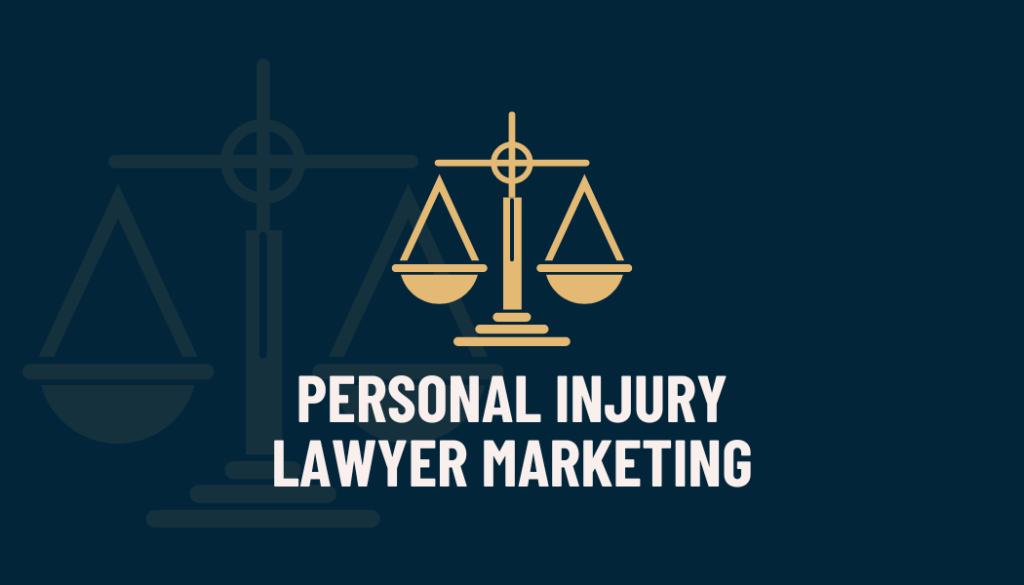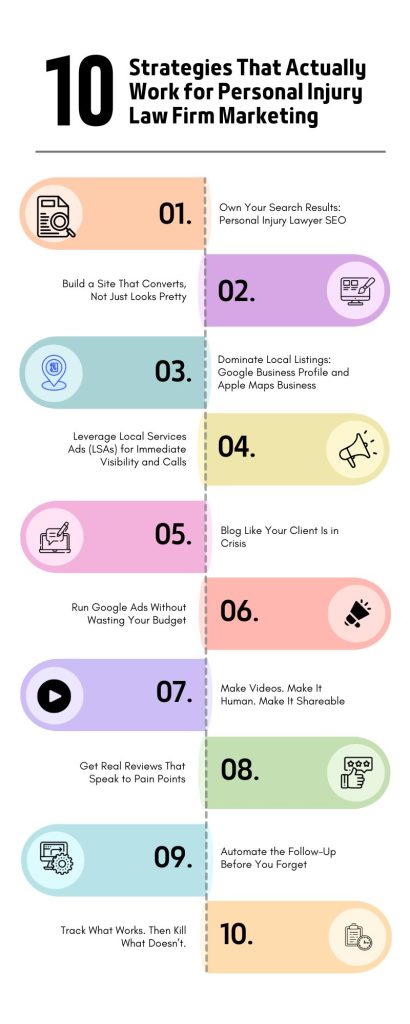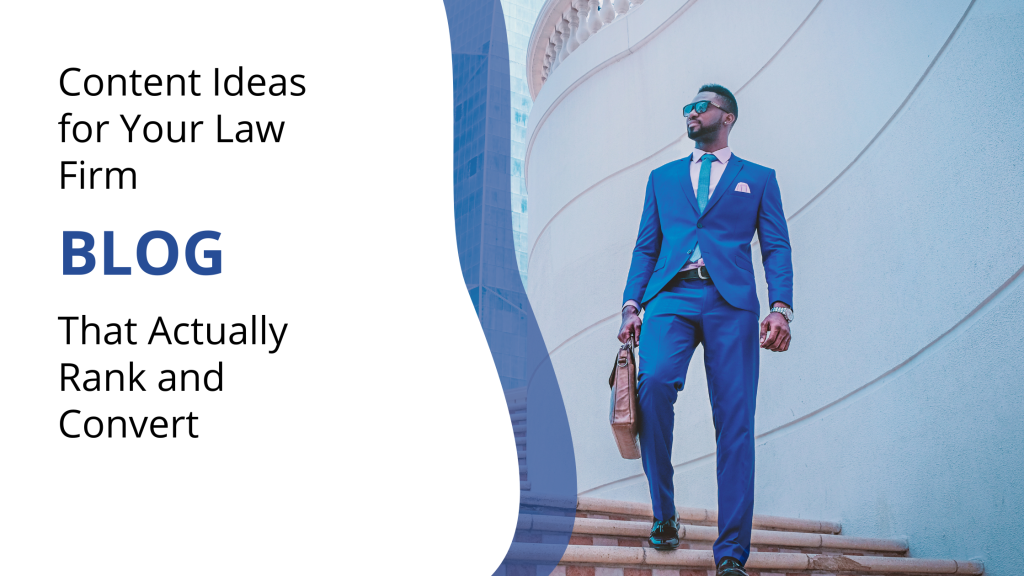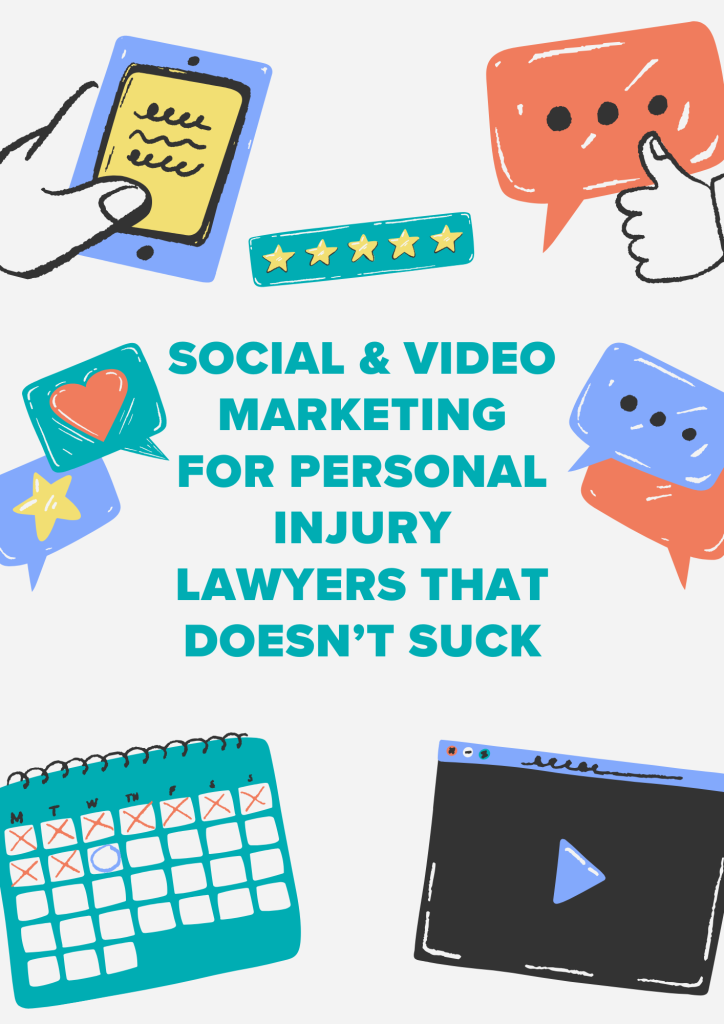Rank, Convert, and Grow in 2025
The Ultimate Guide to Personal Injury Lawyer Marketing
This guide explains everything you need to capture clients using a high-converting personal injury lawyer marketing strategy in 2025, from SEO and Google Ads to automation, content, LSAs, and trust-building tactics.
Personal Injury Lawyer Marketing in 2025
It takes less than a few seconds for someone to decide if you’re the lawyer they’ll call. If your marketing doesn’t speak to urgency and trust, you’re invisible.
Forget the billboards, the slogans, and the lawyer clichés. Marketing in this space isn’t about noise. It’s about intervention and a way to generate personal injury leads online. You need to reach people the moment panic hits and guide them toward clarity. When someone’s hurt and searching for help, they’re not comparing credentials. They’re scanning for confidence.
Your job is to be first, to be relevant, and to be trusted.
That’s what a real personal injury lawyer marketing strategy looks like.
It’s not spam. It’s not fluff. It’s a search engine strategy aligned with human urgency. It’s a homepage that calms anxiety, and its content transforms confusion into action.
Why Most Personal Injury Law Firm Marketing Fails Before It Starts

You can outspend competitors. You can publish more blogs or run the biggest ad campaign in your city. But if your message doesn’t match the mindset of someone in pain, you lose them.
Here’s the truth most agencies won’t tell you: your ideal client doesn’t care about your AV rating, years in practice, or a polished logo. They care about relief. They want someone who understands their fear, takes control of the chaos, and makes legal help feel like a lifeline.
Most law firm marketing collapses because it focuses on tactics before behavior. Clicks are chased without context. Campaigns are launched without empathy. And when that happens, your firm fades into the noise.
People don’t need more ads. They need answers. They need to feel seen, not sold. Your marketing has to meet them in the moment they’re searching after a crash, denied claim, or medical scare. And it has to cut through the clutter fast.
- If your ads sound like everyone else’s, they’re ignored.
- If your content reads like a brochure, it’s forgotten.
- If your homepage doesn’t build trust in five seconds, it’s closed.
The firms that win don’t promote themselves. They promote reassurance. They speak to outcomes, not services. Their websites, ads, videos, and search results all echo the same promise: “We’ve helped people like you, and we can do it again.”
Now let’s talk about the best injury lawyer marketing strategies in 2025.
10 Strategies for Personal Injury Law Firm Marketing

- Own Your Search Results: Personal Injury Lawyer SEO
Your clients aren’t casually browsing. They’re typing with urgency. They’re scared, injured, and looking for someone who feels like the solution. If your website isn’t showing up when that moment hits, your firm doesn’t exist to them.
This is where personal injury lawyer SEO becomes your most powerful asset. Done right, it puts your firm at the top of the search results the exact moment someone types:
- “car accident lawyer free consultation”
- “slip and fall injury lawyer near me”
- “hurt in crash not my fault who to call”
High-intent keywords like these signal immediate need and are the core of law firm SEO for PI attorneys. You don’t want general traffic; you want the person who’s ready to hire now.
Here’s how to take over your search territory:
- Optimize every service page for location and intent. Think “Chicago car accident lawyer” or “Toronto personal injury attorney” — people search locally, especially on mobile.
- Add schema markup to every key page. This includes FAQ, LocalBusiness, Review, and Service schema to increase your visibility in Google’s rich results and local packs.
- Target long-tail keyword questions in your blog. These are the exact phrases that appear in Google’s “People Also Ask” section. Answer them better than anyone else, and you’ll own that real estate.
- Make every word count. Include the phrases your clients use, not legalese. Think like someone who’s overwhelmed and looking for help in plain language.
This isn’t about traffic. It’s about timing. Ranking for high-intent search terms means your firm is visible at the exact second your next client needs you most, and that is what local SEO for lawyers helps you achieve.
- Build a Site That Converts, Not Just Looks Pretty
Your website isn’t a digital brochure; it’s a response to a crisis. When someone lands on your homepage, they’re not admiring colour schemes. They’re looking for reassurance. They want speed, clarity, and a clear next step.
Yet most law firm websites are bloated with legal jargon, vague promises, and slow load times, leaving people more confused than comforted.
Here’s how to build a personal injury website that turns clicks into consultations:
- Make Speed a Priority
If your site takes more than two seconds to load, half your traffic is already gone. Optimize image sizes, reduce plugins, and use a reliable hosting service. Mobile load times are especially critical — most injury clients are searching from a phone.
- Keep Contact Front and Center
Place a visible, clickable call button above the fold on every page. Add a fixed footer with contact info for mobile users. Don’t make them scroll or guess how to reach you.
- Use Real Testimonials with Real Results
Forget “Great lawyer, very professional.” Instead, feature case outcomes and emotional wins:
“They helped me get a $75,000 settlement after my accident, faster than I expected.”
Include photos, names (with permission), and direct quotes. These build trust faster than any badge or headline.
- Mobile-First Isn’t Optional
If your site doesn’t feel effortless on mobile, it’s broken. Buttons must be large enough to tap easily. Text must be readable without zooming. Forms should take under 30 seconds to complete. Test every page like you’re the injured client lying in an ER waiting room — one hand on your phone, the other gripping pain.
- Trust Signals Everywhere
Embed Google review widgets and display your awards sparingly. It will also be a nice touch to add a “secure form” badge next to every contact submission. Link to your Google Business Profile and Apple Maps listing for extra visibility. A great law firm website should not only impress, but also convert. It understands that your potential client is overwhelmed, uncertain, and looking for someone who gets it.
- Dominate Local Listings: Google Business Profile and Apple Maps Business
If you’re not showing up in local search, you’re not even in the race. Your next client isn’t typing in your firm’s name; they’re searching things like “personal injury lawyer near me” or “car accident lawyer open now”. If you’re not visible in the map pack, your competitors are getting those calls, and you are not converting personal injury traffic from maps.
This is where your Google Business Profile (GBP) and Apple Maps business listing become your front-line assets. They are conversion tools that live in the highest-intent zones of search.
You should treat your GBP as a living, breathing profile that must be fully optimized and actively maintained:
- Fill in every field — business name, business address, business phone, operating hours, website URL, and business category
- Upload high-quality photos of your team, office, and logo
- Post updates weekly — think of it as a blog-lite for searchers
- Answer Q&As with keywords — Google indexes these for visibility
Use schema markup on your site (LocalBusiness, Service, FAQ) to reinforce your GBP data. Match your Name, Address, and Phone (NAP) info across every listing and your site to build trust with Google’s algorithm.
Apple Maps is the default maps app for all iOS users, which means millions of high-intent mobile users will see your Apple Maps business listing before your website.
Set up and verify your listing via Apple Business Connect. This free tool lets you optimize and update your information on Apple Maps.
Your listing here influences how Siri, Safari, and Apple Wallet display your business, which means a stronger presence across all Apple services. Unlike other directories, Apple Business Connect gives you full control over your core business information.
- Leverage Local Services Ads (LSAs) for Immediate Visibility and Calls
If you’re personal injury lawyers and you’re not using Google Local Services Ads, you’re leaving qualified leads on the table. Unlike traditional legal PPC campaigns, LSAs only charge you when a potential client actually contacts you. This makes LSA for attorneys one of the most cost-effective tools for generating high-intent phone calls.
Local Services Ads work for personal injury law firms because they appear at the very top of Google search results, often above both organic results and traditional PPC ads. They include your name, business hours, review rating, and a call button. They also come with a significant trust badge: “Google Screened.”
Clients searching for urgent help after an accident are more likely to click on these ads because they convey trust, relevance, and convenience all in one glance.
It is important to set up Google Local Services Ads for injury lawyers because they put you at the top of the results page when intent is at its peak. Someone searching these terms isn’t researching. They’re ready to talk. Your goal is to be the firm they call.
- Blog Like Your Client Is in Crisis
Your potential client is not casually reading legal theory. They’re injured, overwhelmed, and searching for clarity. That’s why your blog content should never feel abstract or robotic. It must feel human, urgent, and useful.
A generic “Top 10 Legal Tips” post won’t cut it. Instead, focus on answering high-intent questions that clients actually type into Google after an accident. These are the searches that signal someone is ready to take action, not just gather information.
Examples of Real Searches You Should Be Writing About:
- “Can I sue if I was rear-ended in Ontario and I’m partly at fault?”
- “How long does a personal injury case take in Canada?”
- “What happens if I don’t report a car accident within 24 hours?”
Blogging on these topics is an opportunity to connect with a frightened client who needs direction. When you show up with clear, direct, and empathetic answers, you instantly position your firm as the one who “gets it.”
When your blog speaks directly to the fears and frustrations of someone in pain, it doesn’t just rank. It resonates. Clients aren’t looking for generic legal guidance; they’re looking for reassurance, next steps, and someone to trust.
A blog that can do all three? That’s not content marketing. That’s conversion.
- Run Google Ads Without Wasting Your Budget
Google Ads can bring in high-value cases fast, but only if you’re targeting the right intent. Most personal injury law firms burn through ad spend chasing broad keywords that don’t convert. A refined paid search strategy focuses on what real clients are searching for when they’re ready to act.
The people clicking your ads should already be considering legal help. That means your keywords should reflect urgency and commercial intent. Go beyond “personal injury lawyer” and dig into specific, ready-to-call terms:
- “Best personal injury lawyer Toronto reviews”
- “Hire no win no fee injury lawyer near me”
- “Slip and fall lawyer free consultation near me”
These phrases are typed by people who are in pain, not just browsing. Make sure your ads speak directly to them. Here are some of the campaign types that work best:
- Call-only campaigns: Perfect for mobile-first searches. They put your phone number front and center.
- Responsive search ads: Let Google test variations to find the best-performing headlines and descriptions.
- Location-based ad extensions: Show your office location, which is especially important if you want to dominate local intent.
Every line of your ad copy should feel like a response to a real fear or question. If someone searches “who pays medical bills after a car accident,” your ad should lead with “Injured in a crash? We’ll handle your medical bills and fight for your compensation.”
- Make Videos. Make It Human. Make It Shareable
Video marketing is no longer optional for personal injury law firms. It builds trust faster than any paragraph on your site and helps clients connect with the person behind the practice. A single authentic video can turn hesitation into a phone call.
Why video works for personal injury lawyers?
- It’s personal: Clients want to see your face, hear your voice, and feel reassured.
- It builds credibility: People are more likely to trust someone who explains things clearly on camera.
- It multiplies visibility: One video can be used on YouTube, LinkedIn, Instagram, Facebook, your homepage, and inside blog posts.
It is important to keep It Simple and Real. You don’t need expensive lighting or scripted speeches. All you need is a smartphone, a quiet space, and the willingness to be real.
Examples of powerful, low-cost video content:
- “Here’s what to expect during your first consultation”
- “Three mistakes people make after a car accident”
- “How we helped a client secure $200,000 after a workplace injury”
Keep most videos under 90 seconds. If you’re explaining something more complex, break it into a short series.
- FAQs: “Do I have a case if I didn’t go to the hospital?”
- Explainers: “What’s the difference between negligence and liability?”
- Story snapshots: “A client slipped in a store and got a fair settlement. Here’s what happened.”
Always end with a clear CTA: “Call now for a free case review” or “Visit our site to check your claim eligibility.”
- Get Real Reviews That Speak to Pain Points
Five-star ratings are nice, but stories win trust. When potential clients read reviews, they’re not scanning for praise. They’re searching for proof. Proof that someone like them got help, that their fear, confusion, or pain was understood and resolved. Reviews are your most powerful marketing tool because they:
- Validate your promises: Reviews confirm that you don’t just talk the talk.
- Improve local SEO: Google and Apple Maps pull signals from review quality and quantity.
- Influence decisions: Over 90% of people read online reviews before choosing a service provider, especially in moments of vulnerability.
A review that says, “Great lawyer!” adds little value. A review that says, “After my accident, I didn’t know where to turn. This firm walked me through every step and got my claim settled quickly,” does the heavy lifting.
The best time to request a review is when emotion runs high. Ask when a client says thank you, receives a settlement, or expresses relief.
Sample script:
“We’re glad we could help. If you have a moment, would you be willing to share your experience? Here’s a quick link that makes it easy.”
Always link directly to your Google review form or Apple Maps listing. Reduce friction. Make it simple.
Note that your clients aren’t professional writers. If you want meaningful feedback, help them tell the right story. Encourage them to mention:
- The issue they faced
- How your firm responded
- The outcome they achieved
- How they felt during and after
This structure turns a casual compliment into a conversion-driving case study.
Example:
“I was overwhelmed after my motorcycle crash. I contacted this firm, and within hours, I had answers. They fought the insurance company and settled my claim faster than expected. I felt heard, supported, and never pressured.”
- Automate the Follow-Up Before You Forget
Great marketing brings in leads, but it’s your follow-up that turns those leads into clients. Far too many personal injury firms lose business because they take too long to respond or completely miss the second touchpoint. That’s where marketing automation for law firms comes in.
Most prospects aren’t comparing dozens of law firms. They’re reaching out to the one that responds first, follows up consistently, and makes the process simple. If your system breaks down after the first contact, you’re handing over clients to more responsive competitors. That is why it is important to know how to automate client intake for personal injury.
Why law firm automation matters:
- Speed equals trust: Responding within minutes tells the client you care and understand urgency.
- Consistency scales your impact: You can’t manually manage every inquiry as your firm grows.
- Nurturing increases conversion: A lead that doesn’t convert today may still need you tomorrow.
These are some of the things you should be automating:
- Initial Lead Acknowledgment
- Send an immediate confirmation email or SMS when someone fills out your contact form.
- Include next steps, your response time, and a way to call directly if it’s urgent.
- Appointment Scheduling
- Use tools like Calendly to offer one-click scheduling.
- Let leads choose their consultation time without a phone call.
- Reminders and Follow-ups
- Send automated reminders 24 hours and 1 hour before scheduled consultations.
- If a lead goes cold, follow up with a short, helpful message in 3 days, 7 days, and 30 days.
- Review Requests
- After a successful case or call, use automation to request a review at the emotional peak of satisfaction.
Track What Works. Then Kill What Doesn’t.
If you’re not measuring, you’re guessing. And in a market as competitive as personal injury law, guessing is expensive. Every ad, blog, landing page, and call script should earn its keep—or get replaced.
Effective marketing is about doing what works more often. Smart firms track their law firm KPIs, everything from phone calls to scroll depth and use real data to guide decisions. These are the key Metrics You Should Be Monitoring:
- Lead Source Attribution
- Know exactly where each lead came from: Google Ads, LSAs, SEO, direct, or referral.
- Use tools like CallRail, WhatConverts, or built-in analytics from your CRM.
- Call Tracking and Quality
- Record and review incoming calls.
- Train your intake team based on what real clients are saying and asking.
- Landing Page Conversions
- Track how many people fill out forms or click-to-call.
- Use heatmaps (like Hotjar or Crazy Egg) to see where users scroll and where they drop off.
- Form Abandonment
- Use analytics tools to monitor when users start a form but don’t submit it.
- Test new layouts or fewer fields to increase completions.
- Ad Campaign ROI
- Monitor impressions and clicks together with cost-per-qualified-lead and cost-per-signed-client.
- Monitor impressions and clicks together with cost-per-qualified-lead and cost-per-signed-client.
- Page Performance
- Bounce rates, time on site, and exit pages tell you what content is connecting or repelling.
- If people are landing but not staying, your messaging is off.
If a landing page has a 2% conversion rate but another has 7%, move your budget and attention to the latter. If a blog drives 10 leads per month while others drive none, build more content around that theme.
Content Ideas for Your Law Firm Blog That Actually Rank and Convert

Your content should be written for people in pain, searching for answers, and ready to act. Blog posts should be specific, emotionally relevant, and tailored to high-intent legal searches. That’s how you build authority and trust at scale.
This is not about publishing for the sake of being active. It’s about intercepting client questions at the exact moment they’re typed into Google.
Topics For Your Personal Injury Lawyer Blog That Drive Traffic and Leads
Each of these is designed to match local search intent, deliver immediate value, and support SEO with real commercial purpose:
- What to Do After a Car Accident in [City]
- How Long Do Personal Injury Settlements Take in Canada?
- Can I Still File a Claim If I Was Partly at Fault?
- No-Win, No-Fee Lawyers in [City]: How It Works
- Slip and Fall Injury: What You Must Document Immediately
- How Much Is My Personal Injury Claim Worth?
- 7 Mistakes People Make After a Car Accident (and How to Avoid Them)
- Medical Malpractice vs. Personal Injury: What’s the Difference?
- What Happens If the Other Driver Doesn’t Have Insurance?
- Should I Talk to the Other Party’s Insurance Company?
SEO Boosters for Blog Posts
- Use internal links to relevant services (car accidents, slip and fall, medical malpractice).
- Add schema markup for FAQ, Article, and Breadcrumbs.
- Make use of headers (H2s and H3s) that match long-tail search terms.
- Embed videos, images, or infographics to increase time-on-page.
- Use meta titles and descriptions with high-intent phrases like “claim,” “lawyer,” and “[City] attorney.”
Social & Video Marketing for Personal Injury Lawyers That Doesn’t Suck

Most law firms treat social media like a notice board. They pin announcements, link blog posts, and wonder why no one engages. That’s not marketing. That’s noise.
To stand out, your content needs to stop the scroll, earn a reaction, and build emotional trust in seconds. Your clients are online. They’re scrolling while in an emergency, while deciding whether to call you, and while comparing options.
Social Platforms That Every Personal Injury Lawyer Should Use
LinkedIn: Use it to build referral relationships with other lawyers and experts.
What works:
- Behind-the-scenes posts explaining your intake process
- Personal insights from real cases (anonymized, of course)
- Carousel posts like “5 things to do after a car crash, lawyer approved”
Facebook: Still the most trusted platform for clients over 35.
What works:
- Local updates like weather-related crash alerts or community events
- Retargeting ads for users who visited your site but didn’t call
- Client testimonial videos under 60 seconds
YouTube: Your most scalable trust-building platform.
Create:
- Short Q&A videos like “Do I have a case if I didn’t report the accident?”
- Explainers on recent legal changes in personal injury law
- Weekly advice clips like “How to file a claim without losing your mind”
Always include captions. Most people scroll without sound. And don’t forget your CTA: “Book a free case review. Link in description.”
Video Content That Actually Converts
No teleprompters. No law office clichés. Just real talk from a real lawyer.
Best-performing formats:
- Rapid-fire FAQs (30 to 60 seconds)
- Client journey storytelling — walk viewers through how you won a case
- Animated explainers showing the legal process visually
- Voiceover with crash footage or diagrams
- “Myth vs. Fact” videos debunking common injury law misconceptions
Use your phone. Use daylight. Use truth. That’s how you get trust.
Reputation is Currency. Reviews Are Proof.
A five-star rating without a story is not convincing enough. A four-star review that tells a real story of relief, trust, and results? That builds credibility faster than any headline.
Potential clients don’t scan testimonials for compliments. They search for evidence. They want to read about someone who had a similar problem, called your firm, and got their life back. If your reviews fail to echo that emotional journey, they won’t move anyone to act.
Timing matters more than wording. Ask when emotions run high, in a good way.
Ask right after:
- A successful settlement
- A favorable court ruling
- A phone call that left the client saying “thank you, I finally feel heard”
Keep it simple. Text them the request with a direct link. Remove friction and you’ll get more responses.
Get Loud or Get Left Behind
If you’re still marketing like it’s 2015, you’re already invisible. Your next client is scrolling right now, looking for something real. They’re not reading legal jargon or staring at static banners. They’re swiping past everything that doesn’t speak to their situation, now.
Billboards don’t bring in cases. Neither do vague slogans or corporate-speak. If your content doesn’t stop them mid-scroll or speak directly to their urgency, they move on. Fast.
This is no longer a game of who has the biggest budget. It’s about who can connect the fastest.
Winning law firms know how to deliver value.
- They publish blog posts that read like answers, not essays.
- They create short-form videos that break down what to do after a crash.
- They share real reviews that speak to fear, relief, and resolution.
- They stop trying to sound perfect and start showing they understand.
If your content doesn’t show proof before they ask for it, if it doesn’t sound like someone who knows what pain feels like, you won’t get the call. You won’t even get the click.
Book a free strategy call and let dNOVO group make your firm unmissable. Schedule Now
Frequently Asked Questions About Personal Injury Lawyer Marketing
What marketing works best for personal injury lawyers?
The fastest wins come from a mix of local SEO, Google Business optimization, and targeted Google Ads. But the long-term dominance is built on trust-based content such as blogs, videos, and reviews, which show clients exactly how you solve real problems.
Is SEO or PPC better for law firms?
Both matter. PPC drives instant leads if you have a budget. SEO builds long-term authority and lowers cost-per-lead over time. Smart firms use PPC to test what converts, then double down on SEO for those terms, and that is how to get personal injury leads. So, we are here to provide you with injury lawyer PPC tips.
How much should a personal injury law firm spend on marketing?
Many firms invest between 7% and 12% of gross revenue. But it’s not about budget size; it’s about ROI. If $1 in gets $4 out, spend until it breaks. Track everything. Scale what performs
What’s the biggest mistake lawyers make in marketing?
They sound like lawyers, not people. Clients don’t want legalese. They want clarity, comfort, and someone who makes the next step feel simple. Speak to pain. Offer outcomes. Skip the jargon.
Can personal injury lawyers advertise on Google?
Yes, and they should. Google is one of the best platforms for injury lawyer ads. Google Local Services Ads (LSAs) are especially effective because you only pay when a client contacts you. Pair LSAs with SEO-rich landing pages to capture both paid and organic traffic.



